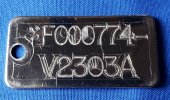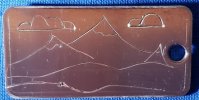alwayslearning2012
Member
Well, Kinda.
I'm getting better with control of the handpiece, but still not where I want to be. If anyone can recommend a graver material that will stand up better than C-Max to Pure Stainless, I'd like to know.
I procured this tag from my current work place. (with the owner's permission, of course. It was the wrong label, and he was going to throw it out)
I had just got my handpiece back from GRS, so I thought I would give it a spin.
My initial plan was to take a V-graver and just remove the laser work. It didn't take long, (seconds, actually) to know my C-max 105, was no match for this tag. But I was determined.
After much sharpening, and little time under the scope, this is the final result.
For the reverse, I had carefully prepared 3 105's to finish it to the end. Needless to say, they didn't quite make it.
The line at the bottom (which I started from the right) got me through until you get to that "mess". That is where I could see the graver had no life left. So I got one of the used ones, and finished it up.
P.S. Layne was right. It IS difficult to photograph engraving work, So if anyone has suggestions for that, as well,
that would be a bonus.
I'm getting better with control of the handpiece, but still not where I want to be. If anyone can recommend a graver material that will stand up better than C-Max to Pure Stainless, I'd like to know.
I procured this tag from my current work place. (with the owner's permission, of course. It was the wrong label, and he was going to throw it out)
I had just got my handpiece back from GRS, so I thought I would give it a spin.
My initial plan was to take a V-graver and just remove the laser work. It didn't take long, (seconds, actually) to know my C-max 105, was no match for this tag. But I was determined.
After much sharpening, and little time under the scope, this is the final result.
For the reverse, I had carefully prepared 3 105's to finish it to the end. Needless to say, they didn't quite make it.
The line at the bottom (which I started from the right) got me through until you get to that "mess". That is where I could see the graver had no life left. So I got one of the used ones, and finished it up.
P.S. Layne was right. It IS difficult to photograph engraving work, So if anyone has suggestions for that, as well,
that would be a bonus.








